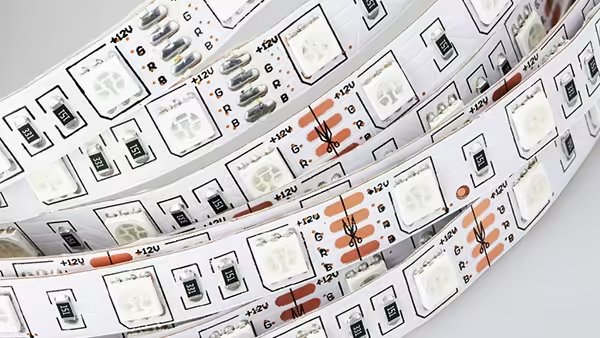RGB vs. RGBW vs. RGBCW vs. RGBNW vs. RGBWW vs. RGBCCT vs. RGBIC vs. RGBWIC LED Strip Lights

Table of Contents
As the popularity of LED strip lights continues to grow, color-changing LED strips have become a favorite among many for their versatility and creative potential. Terms like RGBW and RGBIC can be confusing; this article aims to explain and describe these types of LED strip lights, helping readers better understand their differences.
What Do The Below Letters Mean In LED Strips?
A single LED chip can have one or more diodes, and the emitted light’s color is represented by abbreviations. These abbreviations help in identifying the color and functionality of LED strips. Here’s what the most common terms mean:
RGB: Red, Green, Blue
- Combines red, green, and blue diodes to create a wide range of colors through color mixing.
W: White
- Represents pure white light.
WW: Warm White
- Emits a warm, soft white light, suitable for cozy environments.
CW: Cold White
- Refers to bright, cool white light, ideal for workspaces or clean, modern lighting.
NW: Neutral White
- Balanced white light between warm and cold tones, often used for natural lighting.
CCT (Correlated Color Temperature): Cold White (CW) and Warm White (WW)
- LED strips that allow shifting between cold and warm white tones, providing flexible temperature control by adjusting the brightness of CW and WW diodes.
IC: Integrated Circuit
- Refers to a built-in chip that enables advanced effects like segment control or chasing lights.
Additional Variants:
RGBW: Red, Green, Blue, and White
- Combines RGB colors with a white diode, allowing for more accurate white lighting in addition to color mixing.
RGBCW: Red, Green, Blue, and Cold White
- Adds cold white to the RGB mix for broader lighting capabilities.
RGBNW: Red, Green, Blue, and Neutral White
- Includes neutral white along with RGB for balanced white tones.
RGBWW: Red, Green, Blue, and Warm White
- Combines RGB with warm white, ideal for environments requiring both colorful lighting and warm white ambiance.
RGBCCT: Red, Green, Blue, Cold White, and Warm White
- Contains 5 chips: RGB, Warm White (WW), and Cold White (CW). Unlike RGBW, which only has an additional white diode, RGBCCT allows for precise control of color temperature (CCT) by adjusting the brightness of the CW and WW diodes. This feature enables the strip to shift between cold and warm white tones while still providing full RGB functionality.
RGBWIC: Red, Green, Blue, White, and Integrated Circuit
- Combines RGB and white LEDs with an integrated circuit for dynamic color control and special effects.
RGBIC: Red, Green, Blue, Integrated Circuit
- Similar to RGB but includes a built-in IC (Integrated Circuit) on each segment, allowing different sections of the strip to display multiple colors simultaneously or create effects like color gradients.
These abbreviations help in selecting the right LED strip for your lighting needs, whether you’re looking for dynamic effects, precise color control, or flexible color temperature adjustments.

RGBIC LED strip
Click here to see product specs
How to Choose the Right LED Strip for Your Needs
When selecting an LED strip for your project, understanding the different types is crucial to finding the one that best suits your lighting requirements. LED strips vary significantly in their functionality, from simple, non-addressable options to advanced, addressable strips with dynamic lighting effects. Below is a classification to help you make an informed decision.
Classification of LED Strips: Non-Addressable vs. Addressable
Non-Addressable LED Strips
Non-addressable LED strips (without IC) are the standard option for general lighting. They provide uniform lighting, where all LEDs on the strip behave in the same way—changing color and brightness simultaneously.
Key Features:
- All LEDs act in unison.
- Ideal for simple, static lighting needs.
- More affordable and easier to install.
- Suitable for general residential or commercial lighting.
Examples:
- RGB: Standard RGB LED strips that combine red, green, and blue diodes to create various colors across the entire strip.
- RGBW, RGBCW, RGBNW, RGBWW: Variants that combine RGB colors with white (W), cold white (CW), neutral white (NW), or warm white (WW) for added flexibility but with uniform light output across the strip.
Addressable LED Strips
Addressable LED strips (with IC) provide more advanced functionality by allowing individual control of each LED or specific sections. These strips are perfect for creating dynamic effects, such as color gradients, chasing lights, or even multi-color displays within the same strip.
Key Features:
- Individual control of each LED or segment.
- Enables dynamic effects like color chasing, gradients, and animations.
- More complex control and installation but allows for versatile and interactive lighting.
Examples:
- RGBIC: Features RGB diodes and an Integrated Circuit (IC), allowing control of different segments for effects like color gradients or chasing lights.
- RGBWIC: Adds a white diode to RGBIC, enabling both dynamic effects and precise white light control.
- RGBCCT (With IC): Includes 5 chips (RGB, Cold White, and Warm White) and IC, allowing adjustment of color temperature (CCT) by controlling the brightness of the cold and warm white chips. This option provides both colorful lighting and customizable white tones.
Can RGB Produce White Light? If So, What Is the Purpose of RGBW or RGBCCT?
Can RGB produce white light?
Yes, RGB LED strips can produce white light by combining red, green, and blue diodes at full brightness. However, the white light produced by RGB is based on mixing three monochromatic chips (red, green, and blue). This type of light is quite different from the light emitted by a dedicated white chip. By observing their wavelength spectrum or color temperature, you’ll notice a significant difference between RGB-generated white light and true white light from a white diode.
That said, in many applications where color rendering index (CRI) or light waveform isn’t crucial, RGBIC is often a more cost-effective option. It provides dynamic lighting effects and can simulate white light adequately for many general purposes.
What is the purpose of RGBW or RGBCCT?
RGBW: The addition of a dedicated white diode allows the strip to produce a true white light, which is much more accurate and visually consistent than the RGB-generated white. This ensures better color balance and higher quality of white light output.
RGBCCT: This type of LED strip includes five chips: red, green, blue, warm white (WW), and cold white (CW). RGBCCT strips enable adjustment of the color temperature by controlling the brightness of the WW and CW chips, offering a wide range of white light—from warm to cool—along with vibrant RGB color effects. This is ideal for environments requiring precise white lighting with the flexibility to adjust the warmth or coolness of the light.
In summary, while RGB can simulate white light, RGBW and RGBCCT strips offer more accurate and versatile white lighting. RGBIC remains an economical choice for many applications, but RGBW and RGBCCT are better suited for environments requiring precise control over light quality and color temperature.
Need More Information?
If you have any further questions about products or usage, feel free to contact our experts online for more information. We’re here to help you make the right choice for your lighting needs!

